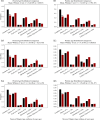Mechanisms of transcriptional regulation in Anopheles gambiae revealed by allele-specific expression
- PMID: 39288798
- PMCID: PMC11407855
- DOI: 10.1098/rspb.2024.1142
Mechanisms of transcriptional regulation in Anopheles gambiae revealed by allele-specific expression
Abstract
Malaria control relies on insecticides targeting the mosquito vector, but this is increasingly compromised by insecticide resistance, which can be achieved by elevated expression of detoxifying enzymes that metabolize the insecticide. In diploid organisms, gene expression is regulated both in cis, by regulatory sequences on the same chromosome, and by trans acting factors, affecting both alleles equally. Differing levels of transcription can be caused by mutations in cis-regulatory modules (CRM), but few of these have been identified in mosquitoes. We crossed bendiocarb-resistant and susceptible Anopheles gambiae strains to identify cis-regulated genes that might be responsible for the resistant phenotype using RNAseq, and CRM sequences controlling gene expression in insecticide resistance relevant tissues were predicted using machine learning. We found 115 genes showing allele-specific expression (ASE) in hybrids of insecticide susceptible and resistant strains, suggesting cis-regulation is an important mechanism of gene expression regulation in A. gambiae. The genes showing ASE included a higher proportion of Anopheles-specific genes on average younger than genes with balanced allelic expression.
Keywords: allele; cis-regulation; insecticide; resistance; transcript.
Conflict of interest statement
We declare we have no competing interests.
Figures





Update of
-
Mechanisms of transcriptional regulation in Anopheles gambiae revealed by allele specific expression.bioRxiv [Preprint]. 2023 Dec 15:2023.11.22.568226. doi: 10.1101/2023.11.22.568226. bioRxiv. 2023. Update in: Proc Biol Sci. 2024 Sep;291(2031):20241142. doi: 10.1098/rspb.2024.1142. PMID: 38045426 Free PMC article. Updated. Preprint.
Similar articles
-
Mechanisms of transcriptional regulation in Anopheles gambiae revealed by allele specific expression.bioRxiv [Preprint]. 2023 Dec 15:2023.11.22.568226. doi: 10.1101/2023.11.22.568226. bioRxiv. 2023. Update in: Proc Biol Sci. 2024 Sep;291(2031):20241142. doi: 10.1098/rspb.2024.1142. PMID: 38045426 Free PMC article. Updated. Preprint.
-
Depressing time: Waiting, melancholia, and the psychoanalytic practice of care.In: Kirtsoglou E, Simpson B, editors. The Time of Anthropology: Studies of Contemporary Chronopolitics. Abingdon: Routledge; 2020. Chapter 5. In: Kirtsoglou E, Simpson B, editors. The Time of Anthropology: Studies of Contemporary Chronopolitics. Abingdon: Routledge; 2020. Chapter 5. PMID: 36137063 Free Books & Documents. Review.
-
Development of molecular assays to detect target-site mechanisms associated with insecticide resistance in malaria vectors from Latin America.Malar J. 2019 Jun 20;18(1):202. doi: 10.1186/s12936-019-2834-7. Malar J. 2019. PMID: 31221148 Free PMC article.
-
A new WHO bottle bioassay method to assess the susceptibility of mosquito vectors to public health insecticides: results from a WHO-coordinated multi-centre study.Parasit Vectors. 2023 Jan 20;16(1):21. doi: 10.1186/s13071-022-05554-7. Parasit Vectors. 2023. PMID: 36670470 Free PMC article.
-
Continuing education meetings and workshops: effects on professional practice and healthcare outcomes.Cochrane Database Syst Rev. 2021 Sep 15;9(9):CD003030. doi: 10.1002/14651858.CD003030.pub3. Cochrane Database Syst Rev. 2021. PMID: 34523128 Free PMC article. Review.
Cited by
-
Copy number variants underlie the major selective sweeps in insecticide resistance genes in Anopheles arabiensis from Tanzania.bioRxiv [Preprint]. 2024 Mar 13:2024.03.11.583874. doi: 10.1101/2024.03.11.583874. bioRxiv. 2024. Update in: PLoS Biol. 2024 Dec 5;22(12):e3002898. doi: 10.1371/journal.pbio.3002898. PMID: 38559088 Free PMC article. Updated. Preprint.
References
-
- World Health Organization . 2019. World malaria report 2019. Geneva, Switzerland: World Health Organization.
MeSH terms
Substances
Grants and funding
- Royal Society
- Wellcome Sanger Institute
- National Institute of Allergy and Infectious Diseases
- European Union
- BB_/Biotechnology and Biological Sciences Research Council/United Kingdom
- Pan-African Mosquito Control Association
- NIAID
- The Liverpool School of Tropical Medicine
- The Pan-African Mosquito Control Association
- Daphne Jackson Fellowship
- MR/P02520X/1/MRC_/Medical Research Council/United Kingdom
- MalariaGEN Vector Observatory
- R01 AI116811/AI/NIAID NIH HHS/United States
- Sanger Institute
- Broad Institute of Harvard and
- Liverpool School of Tropical Medicine
- WT_/Wellcome Trust/United Kingdom
- MR/T001070/1/MRC_/Medical Research Council/United Kingdom
- Bill and Melinda Gates Foundation
LinkOut - more resources
Full Text Sources

